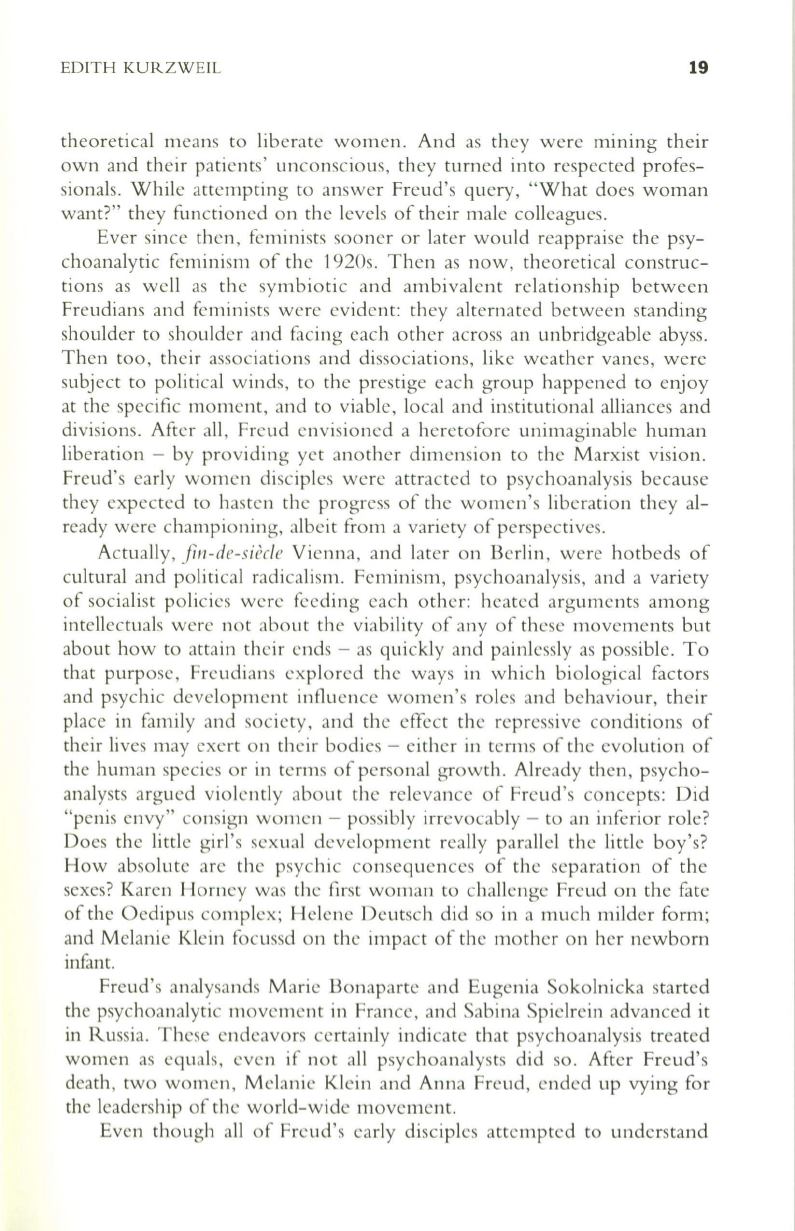
EDITH KURZWEIL
19
theoretical means to liberate women. And as they were mining their
own and their patients' unconscious, they turned into respected profes–
sionals. While attempting to answer Freud's query, "What does woman
want?" they functioned on the levels of their male colleagues.
Ever since then, feminists sooner or later would reappraise the psy–
choanalytic feminism of the 1920s. Then as now, theoretical construc–
tions as well as the symbiotic and ambivalent relationship between
Freudians and feminists were evident: they alternated between standing
shoulder to shoulder and facing each other across an unbridgeable abyss.
Then too, their associations and dissociations, like weather vanes, were
subject to political winds, to the prestige each group happened to enjoy
at the specific moment, and to viable, local and institutional alliances and
divisions. After all, Freud envisioned a heretofore unimaginable human
liberation - by providing yet another dimension to the Marxist vision.
Freud's early women disciples were attracted to psychoanalysis because
they expected to hasten the progress of the women's liberation they al–
ready were championing, albeit from a variety of perspectives.
Actually,
fill-de-siecle
Vienna, and later on Berlin, were hotbeds of
cultural and political radicalism. Feminism, psychoanalysis, and a variety
of socialist policies were feeding each other: heated arguments among
intellectuals were not about the viability of any of these movements but
about how to attain their ends - as quickly and painlessly as possible. To
that purpose, Freudians explored the ways in which biological factors
and psychic development influence women's roles and behaviour, their
place in family and society, and the effect the repressive conditions of
their lives may exert on their bodies - either in tenm of the evolution of
the human species or in terms of personal growth. Already then, psycho–
analysts argued violently about the relevance of Freud's concepts: Did
"penis envy" consign women - possibly irrevocably - to an inferior role?
Does the little girl's sexual development really parallel the little boy's?
How absolute are the psychic consequences of the separation of the
sexes? Karen Horney was the first woman to challenge Freud on the fate
of the Oedipus complex; Helene Deutsch did so in a much milder form;
and Melanie Klein focussd on the impact of the mother on her newborn
infant.
Freud's analysands Marie Bonaparte and Eugenia Sokolnicka started
the psychoanalytic movement in France, and Sabina Spielrein advanced it
in Russia. These endeavors certainly indicate that psychoanalysis treated
women as equals, even if not all psychoanalysts did so. After Freud's
death, two women, Melanie Klein and Anna Freud, ended up vying for
the leadership of the world-wide movement.
Even though all of Freud's early disciples attempted to understand


